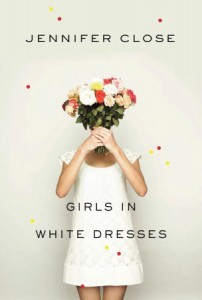by Jennifer Close
If you are, or used to be, a twenty-something woman living in New York City, you will undoubtedly feel a perverse attraction to Jennifer Close’s debut novel-in-stories Girls in White Dresses. Why perverse? Because this book will likely hurt you. It will remind you (if you’re lucky enough to have hit age 30) or reflect back to you (if you’re in the thick of your twenties) just how painful young, single, city life can be. Worse, despite what you know to be in your emotional best interest, you won’t be able to put the book down. You’ll be pushed forward by a fierce desire to see the characters triumph, to see them stand up for themselves so that they may come out ahead, even once. But as the twenty-something that you were/are, you know exactly what Close is doing. She’s sending her characters down a long tortuous road to—well, if not happiness exactly, than maybe a kind of wisdom.
Girls in White Dresses is the anti-chicklit. There are no poufy lap dogs or shopping sprees or cosmopolitans. High heels do make an appearance (the characters attend weddings and bridal showers) but their beverage of choice is beer, and their preferred fashion is sweat pants. Close’s characters are “chicks” only in the sense that they start out the book newly hatched from college. Otherwise, the women who feature in these stories are refreshingly bizarre. There is Lauren who at one time believed that a ham was “an over shaped-hunk of an animal that slurped across the ground” and who “sucked [her boyfriend’s] blond curls when he was sleeping.” There is Ellen, who is beautiful, but pines after a Louis: a 90-pound, chain-smoking, pretentious geek. Isabella develops an intense sympathy for a girl who is the spitting image of JonBenét Ramsey and Amy comes to see her life in terms of “gimpy” peahens who follow the majestic peacock “because [it’s] all they [know] how to do.”
Close’s language is direct and specific. She is particularly adept at ending scenes on a snarky note. I particularly warmed to this finish: “You’re mother’s a moron,” Abby said into the phone, and then she hung up. And to this one, in which Isabella is visiting Coco, a new mom: “Coco was funnier than [Isabella] remembered, which was maybe due to the fact that she’d got a little fat during her pregnacy…Isabella liked Fat Coco more than she’d ever liked the other one.”
The sardonic tone, of course, is a symptom of the profound loneliness Close’s character’s feel. The Girls in these stories care deeply for one another, but these female connections are never quite enough. Close writes about Isabella who has just moved into her own apartment: “Sometimes she talked out loud just to hear her voice…“I think I’ll make a tuna sandwich,” she should say to no one. “Or maybe a veggie burger,” she would tell the couch. Like I said before, funny but painful.
There’s an irony, of course, in how this book portrays its protagonists’ isolation. True to its title (as well as the cover art, which depicts a young bridesmaid holding a bouquet in front of her face), Close’s book isn’t about any one character but about the collective. Quite purposefully, she presents each girl as a reflection of one another. For this reason, I had a difficult time keeping them straight from one story to the next. I had to go searching to remember who was dating whom, how long it had been since the last breakup, and how old they were at any given moment. This was frustrating, but it also forced me to be fully immersed in the lives of The Girls, plural. It reminded me that not so long ago, I was one of them and all of them.
Jennifer Miller’s debut novel, The Year of the Gadfly, will be published by Houghton-Mifflin-Harcourt in May, 2012. You can reach her on twitter @propjen or at www.byjennifermiller.com
This post may contain affiliate links.









